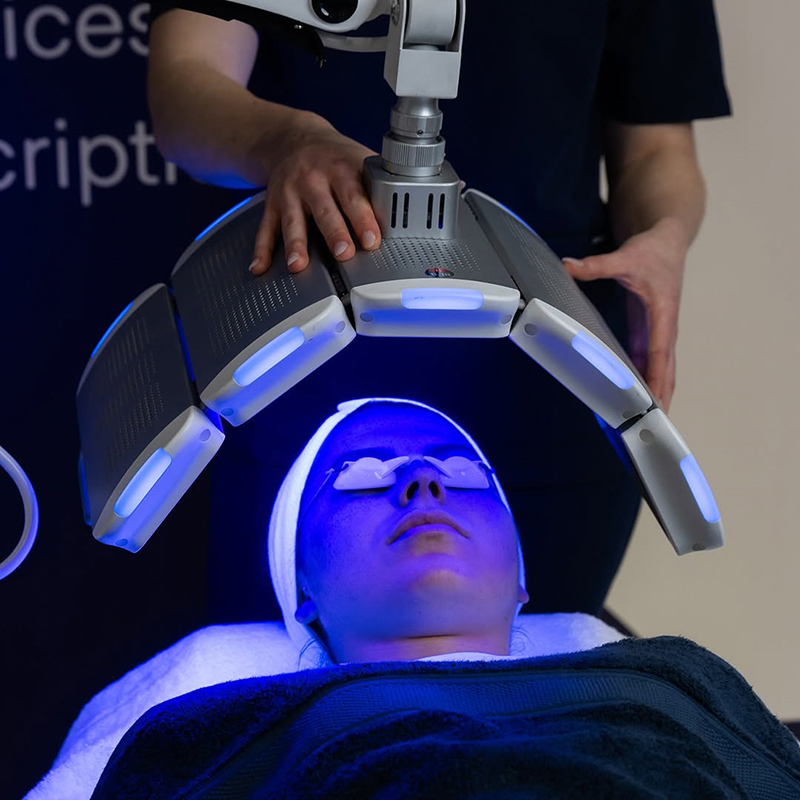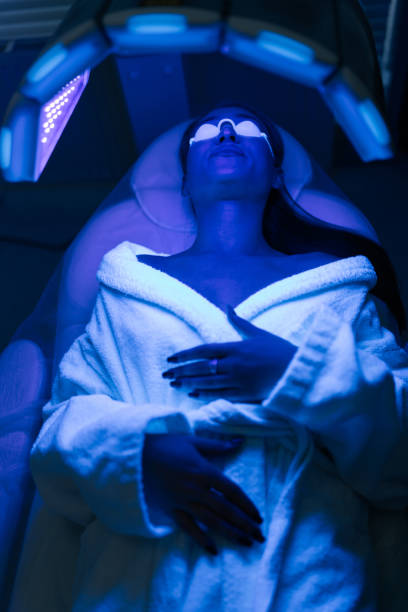
LED Photodynamic Therapy: A New Standard for Acne and Actinic Keratosis Treatment
2025-09-17 17:39Introduction: Light-Based Innovation in Dermatology
Over the past two decades, dermatology has increasingly embraced light-based technologies. Among them, LED photodynamic therapy (LED-PDT) has proven highly versatile for treating both inflammatory and precancerous skin conditions. Despite different causes—acne linked to sebaceous activity and bacteria, actinic keratosis to UV-induced DNA damage—both remain difficult to manage and impact patients’ quality of life.
Traditional therapies face limits such as antibiotic resistance, systemic side effects, and cosmetic concerns. By contrast, LED-PDT combines biological precision with patient comfort. Backed by 28 years of phototherapy expertise, KernelMed offers a full range of LED-PDT systems designed for modern dermatology practices.
Acne: Beyond Adolescence, Toward Lifelong Management
Epidemiology and Evolving Patient Profiles
Acne remains one of the most common dermatological conditions worldwide, affecting nearly 9.4% of the global population (JAAD, 2022). Historically considered a teenage disease, the reality today is far more complex. Adult acne is steadily increasing, particularly in women aged 25–40, due to hormonal, lifestyle, and environmental factors. In addition to visible lesions, acne often leaves psychological scars, contributing to depression, anxiety, and social withdrawal. Its long-term impact on quality of life is substantial, making it more than a “cosmetic concern.”
Limitations of Current Therapies
Despite the availability of multiple treatment classes, patient dissatisfaction remains high. Topical agents such as retinoids and benzoyl peroxide are frequently limited by irritation and poor adherence. Oral antibiotics are widely prescribed, but their contribution to global antimicrobial resistance is raising alarm within public health communities. Oral isotretinoin is highly effective yet constrained by strict monitoring protocols and teratogenic risks. This therapeutic landscape creates a strong demand for non-drug, non-invasive alternatives that are both effective and safe for long-term management.
Mechanism of LED-PDT in Acne
Photodynamic therapy integrates three fundamental elements: a photosensitizing agent, an activating light source, and oxygen within skin tissue. When agents like 5-aminolevulinic acid (ALA) or methyl aminolevulinate (MAL) are applied topically, they are metabolized into protoporphyrin IX (PpIX), a potent photosensitizer. Upon exposure to LED light at specific wavelengths, PpIX produces reactive oxygen species (ROS), which exert targeted cytotoxic effects.
In acne, these ROS act on two major pathological drivers:
Cutibacterium acnes reduction – the bacteria central to acne inflammation are directly destroyed.
Sebaceous gland modulation – overactive sebocytes are selectively damaged, leading to decreased sebum production and reduced lesion recurrence.
Why LEDs Are Preferred
While lasers and intense pulsed light (IPL) can also activate PpIX, LED systems present distinct advantages. LEDs provide uniform energy delivery across wide treatment areas, minimizing hotspots and improving tolerability. Their lower thermal output reduces discomfort, making them suitable for repeated sessions. Furthermore, LEDs are cost-effective, portable, and versatile, qualities that align with modern clinical workflows and patient expectations.
Clinical Evidence: LED-PDT in Acne Therapy
The clinical value of LED-PDT in acne management is now supported by a growing body of evidence. A randomized controlled trial published in PubMed (2019) found that patients receiving combined red (630 nm) and blue (415 nm) LED-PDT experienced a 65% reduction in inflammatory lesions after just four weeks. A meta-analysis in the Journal of Dermatological Treatment (2021) further confirmed that PDT is effective in moderate-to-severe acne, achieving significant clearance with minimal side effects limited to transient erythema and dryness.
Long-term studies demonstrate that LED-PDT not only addresses active breakouts but also suppresses sebaceous hyperactivity, reducing relapse frequency. Importantly, sessions are short, require no systemic medication, and patients can resume daily activities immediately, strengthening its appeal in busy lifestyles.
Actinic Keratosis: A Precancerous Challenge
Prevalence and Risks
Actinic keratosis represents one of the most common precancerous skin conditions caused by cumulative UV radiation exposure. According to JAAD (2021), up to 25% of adults over 40 living in high-sunlight regions exhibit AK lesions. While not all lesions progress, untreated AK carries a measurable risk of evolving into invasive squamous cell carcinoma (SCC). Given the aging global population and rising UV exposure due to lifestyle changes, AK prevalence is projected to increase further in coming decades.
Current Limitations of Standard Care
Conventional treatments for AK include cryotherapy, topical 5-fluorouracil, and surgical excision. Each carries drawbacks: cryotherapy may result in hypopigmentation or scarring; topical 5-FU requires weeks of use with considerable irritation; surgery is impractical for patients with widespread lesions. The unmet need is clear: a non-invasive, repeatable therapy with superior cosmetic outcomes.
LED-PDT in Actinic Keratosis
PDT has proven particularly well-suited for AK. Photosensitizers preferentially accumulate in atypical keratinocytes, and LED activation produces ROS that selectively destroy these precancerous cells while sparing normal tissue. Unlike destructive approaches, PDT offers the dual benefits of efficacy and favorable cosmetic results.
Clinical Studies Supporting LED-PDT for AK
Evidence from multiple trials validates LED-PDT in AK management. A comparative study published in JAAD (2018) found that while daylight PDT was effective, LED-PDT provided more consistent and weather-independent results. A multicenter study reported in PubMed (2020) achieved complete clearance rates of 70–90% for AK lesions treated with LED-PDT, with patients reporting lower pain scores compared to traditional light sources. These outcomes underscore both the therapeutic reliability and patient satisfaction associated with LED-based systems.
Comparative Advantages of LED-PDT Devices
Compared with lasers, IPL, and daylight PDT, LED systems demonstrate distinct clinical and practical advantages:
Controlled, reproducible energy delivery – ensuring consistent therapeutic outcomes.
Minimal heat generation – reducing discomfort and enabling better patient compliance.
Wavelength versatility – blue light penetrates superficial lesions, red light reaches deeper targets, and yellow light addresses vascular components.
Adaptability – from portable handheld units to large full-body systems, devices can be tailored for hospital, clinic, or even home settings.
These characteristics position LED-PDT devices as the most flexible and patient-friendly choice for dermatology practices seeking to expand their treatment portfolio.
KernelMed’s Solutions: Designed for Global Clinical Needs
KernelMed has leveraged decades of phototherapy expertise to create a diverse range of LED Photodynamic Therapy Systems. Its portfolio includes multi-wavelength platforms integrating red (630 nm), blue (415 nm), and yellow (590 nm) light for targeted applications. All systems are ergonomically designed for ease of use, from compact desktop units suitable for private clinics to large-scale systems for hospital dermatology departments.
KernelMed devices hold CE and FDA certifications, ensuring compliance with international regulatory standards. Already deployed across Europe, the Middle East, and Asia-Pacific, they are supported by robust distributor partnerships and comprehensive after-sales services. This global footprint demonstrates both the trust of practitioners and the scalability of KernelMed’s technologies.
Market Opportunities and Business Potential
Acne Treatment Market
The global acne treatment market is valued at over USD 10 billion and is projected to exceed USD 14 billion by 2030 (GlobalData, 2023). As patient demand shifts toward non-antibiotic and device-based options, LED-PDT represents one of the fastest-growing niches. Clinics offering advanced acne solutions can differentiate themselves while meeting rising consumer expectations.
Actinic Keratosis Market
The AK treatment segment is expanding rapidly, driven by demographic shifts and lifestyle patterns. Non-invasive options like LED-PDT are gaining preference, with dermatology practices increasingly integrating these systems for better outcomes and cosmetic results. The ability to deliver repeatable, painless sessions creates a sustainable model for patient retention and clinic growth.
Distributor Value Proposition
For distributors, the business case is compelling. KernelMed offers more than just devices—it provides training, marketing support, and long-term partnership opportunities. With a scalable product line ranging from entry-level to premium systems, distributors can target diverse market segments and capture strong margins. As awareness of LED-PDT continues to expand globally, early adopters are well-positioned to secure market share.
Conclusion: Bridging Science, Patient Care, and Business Growth
LED photodynamic therapy has transcended its early experimental phase to become a validated, mainstream option for managing acne and actinic keratosis. By combining clinical efficacy, safety, and convenience, LED-PDT addresses longstanding gaps left by traditional treatments. For patients, it means faster recovery, improved cosmetic outcomes, and enhanced quality of life. For clinics, it expands service capabilities and strengthens competitiveness. For distributors, it represents a market opportunity with long-term profitability.
KernelMed stands at the forefront of this transformation, offering advanced, globally recognized devices supported by decades of expertise. For healthcare providers and business partners alike, the time to embrace LED-PDT is now.
👉 Explore the full portfolio here: Kernel LED Photodynamic Therapy Systems


